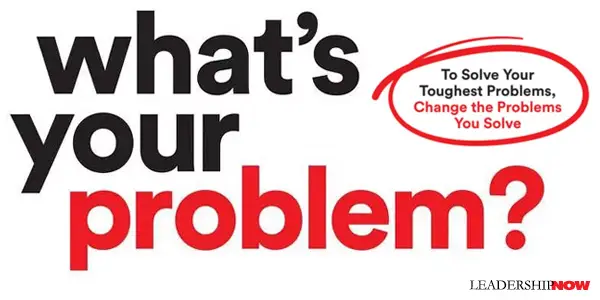 |
 |
03.30.20

What’s Your Problem?
WE HEAR A LOT about reframing, but do we actually do it? True. We get busy, and we start looking for a solution without first analyzing the problem. We want a quick solution so we can move on. And we “solve” the wrong problem. Reframing helps us to avoid this. Reframing helps us to see solutions that we would otherwise not see, as we see the issue from different angles. Sometimes the process of reframing leads us to discover that what we thought was the problem is not really the problem at all. It is a symptom of the problem. Solving for symptoms locks us into a perpetual crisis loop like a hamster on an exercise wheel. We end up with laws and rules that solve nothing because we’re solving the wrong problem. Thomas Wedell-Wedellsborg helps us get a handle on this reframing skill in What's Your Problem?: To Solve Your Toughest Problems, Change the Problems You Solve. “Sometimes,” writes Thomas, “to solve a hard problem, you have to stop looking for solutions to it. Instead, you must turn your attention to the problem itself—not just to analyze it, but to shift the way you frame it. Reframing is not necessarily about the details. It is more about seeing the big picture and having the ability to consider situations from multiple perspectives.” Reframing There are two different ways of reframing a problem: exploring the frame and breaking the frame.
When exploring the frame, you’re looking for aspects of the issue that you might not have considered. “Breaking the frame is when you step away completely from the initial framing of the problem.” It is the more important of the two skills because “if you don’t master it, you will get trapped by the initial framing of the problem.” Thomas provides several examples that help you to see reframing in practice. Reframing, says Thomas, is like a loop off of the straight-line path to a solution. It is “a brief, deliberate redirection that temporarily shifts people’s focus to the higher-level question of how the problem is framed. It results in getting back on the path with a new or improved understanding of the problem.” Problems present themselves in three ways: “an ill-defined mess or pain point, a goal we don’t know how to reach, or a solution someone fell in love with.”
How to Reframe Thomas introduces a method we can use on any problem that we face. No problem is too big or too small. He recommends that we “modify the reframing process to fit the size of the problem.” In other words, you can either use all seven steps in the process or scale it down according to how much time is available. “You don’t necessarily have to stick to the sequence. When solving problems as part of a quick workplace conversation, feel free to jump straight to the particular strategy that seems most promising given the problem at hand.” Complex problems take more time to reframe, but some can be reframed in as little as five minutes. The important consequence of understanding this process is that you become more curious and intentional with problem-solving. You begin to ask questions instead of just jumping to a solution.
Here is a brief overview without all of the insightful and instructive examples: Frame the Problem Look Outside the Frame Rethink the Goal Examine Bright Spots Look in the Mirror Take Their Perspective Research has shown that people focus too much on their own perspective when trying to understand others. Try to disregard your own preferences. Focus only on how they might feel and think. Move Forward Thomas also offers some approaches when dealing with people who resist the process and those who are in denial. What’s Your Problem? is the most thorough and practical book you’ll read on this critical habit of problem-solving and thinking well. Well-illustrated, and full of clarifying examples, he teaches you how to reframe any issue you encounter in either your personal or professional life. On the What’s Your Problem? website, you can find a Reframing Worksheet and Checklist, and other useful downloads. 
Posted by Michael McKinney at 06:20 PM
|
BUILD YOUR KNOWLEDGE
 

How to Do Your Start-Up Right STRAIGHT TALK FOR START-UPS 
Grow Your Leadership Skills NEW AND UPCOMING LEADERSHIP BOOKS 
Leadership Minute BITE-SIZE CONCEPTS YOU CAN CHEW ON 
Classic Leadership Books BOOKS TO READ BEFORE YOU LEAD |